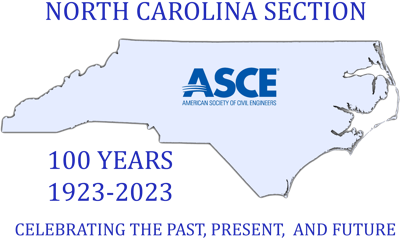Several engineers organized the North Carolina Section on October 24, 1923 within the parlors of the Presbyterian Church near the Malbourne hotel in Durham, North Carolina. Mr. Gilbert C. White, Consulting Engineer of Durham, invited the Secretary of ASCE, Mr. John H. Dunlap, to speak about the creation of local sections to himself and sixteen other engineers in order to form the 42nd Section of ASCE. A constitution was adopted and Charles E. Waddell, Consulting Engineer of Asheville, was unanimously elected the first President. On November 9, 1923 the Constitution was approved by ASCE and the first regular meeting of the North Carolina Section was held in Asheville on August 11-13, 1924. Section dues were initially $3 and almost 80 years later are about $15, which are paid as part of the yearly dues to ASCE National.
The Malbourne Hotel which once stood at the northwest corner of Main Street at Roxboro Street in Durham, North Carolina
Outreach to the student chapters has always been a major priority of the North Carolina Section. Beginning in 1923 and continuing today, the NC Section has always tried to support and nurture its student chapters. In 1926 the first student chapter prize was awarded to J. M. Jarrett of Asheville, NC, a senior at North Carolina State College. his prize was having his first year of dues to ASCE paid in full, $3! There were two student chapters in the 1920s: North Carolina State College and the University of North Carolina at Chapel Hill. Duke University's Student Chapter was organized in 1932 and the NC Section commenced awarding three student prizes of $25 each. Today, the scholarship committee provides four scholarships: Three at $1500 and one grand prize of $3500 to students at each of the four ASCE Student Chapters now in North Carolina: North Carolina State University, Duke University, University of North Carolina at Charlotte and North Carolina A&T.
The annual meeting of the North Carolina Section has been held in various cities throughout North Carolina. Nine different cities have hosted the annual meeting with Raleigh, Charlotte and Greensboro hosting twenty, seventeen and ten meetings, respectively. The time of the annual meeting has varied as well. During the first thirty years most annual meetings were held in January. Since then the fall has been the time when the Section has held its annual meeting.
The North Carolina Section has always tried to keep its members informed of various items that are important to its members. The first formal effort was a quarterly magazine entitled NC Civil Engineer. It was published between 1939 and 1941. Beginning in 1964 and continuing to this day The Bulletin has kept members informed on a bimonthly basis. More than eight individuals have served as editor of The Bulletin.
Committees have played an important role within the North Carolina Section since its inception. The initial six committees formed by the section were: Joint Conference, Local Sections, Nominating, Research, Student Chapters and Technical Activities Publications. By 1970 the section had fourteen committees: Membership, Conditions of Practice, Program, Public Relations, Auditing, Necrology, Student Activities, Appointment and Honors, Nominating, Local Arrangements - Annual Meeting, Section Newsletter, Legislative, History & Heritage and Continuing Education. The current standing committees are: Annual Meeting, Bulletin, Engineering Management, Nominating, Scholarship and 1506 Anniversary. In addition to the standing committees there are four Directors: Legislative Affairs, Auditing, Student Activities, Web Master; and five Technical Groups: Construction Materials, Geotechnical, Structural, Transportation and Water Resources. The true strength of any organization is measured by the activity and goals accomplished by its committees. The North Carolina section committees, year in and year out, accomplish their goals.
Civil engineering projects have improved the built environment throughout North Carolina. In 1999 the Blue Ridge Parkway was designated a National Historic Civil Engineering Landmark (NHCEL). The Cape Hatteras Lighthouse relocation project received the Outstanding Civil Engineering Award in 2000 and was designated a NHCEL in 2001. The Bunker Hill Covered bridge in Catawba County was designated a NHCEL in 2001 as the only remaining example of a wooden Haupt Truss. In 2002, the Dorton Arena in Raleigh and Fontana Dam in Graham County were designated as NHCEL and North Carolina CEL, respectively.
Five Branches comprise the North Carolina section. The 'granddaddy' is the Western Branch, which joined the Tennessee Valley Section in 1937 and became a part of the NC Section in 1971. It includes twenty counties and holds the majority of its meetings in Asheville. In 1962 the Section created the 'triplets': Eastern, Northern and Southern Branches. The Eastern Branch serves twenty-nine counties and usually meets in Raleigh, the Northern and Southern branches are both comprised of fourteen counties and generally meet in Greensboro and Charlotte, respectively. The Coastal Branch is the baby, formed in 1982. It meets in the Wilmington area and includes twenty-three counties.
The North Carolina section has an outstanding list of past presidents. The leadership of the section has been responsible for the excellent reputation it enjoys today. Several have played important roles on the national level as well. Mr. James E Davis, PE graduated from North Carolina State University and previously served as the Executive Director and CEO of ASCE. Recently, the North Carolina section has had two past presidents serve as national Vice Presidents of ASCE: Dr. David M. Bayer, PE served as a Vice President in the mid 1990s and Mr. Thomas S. Slater, PE served as a Vice President in the early 2000s.


